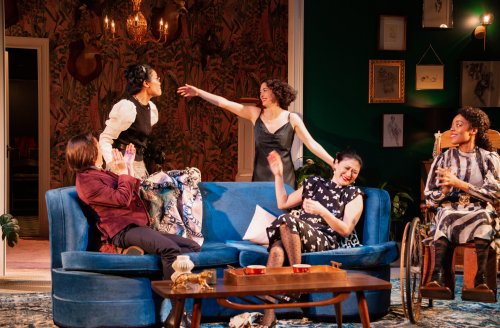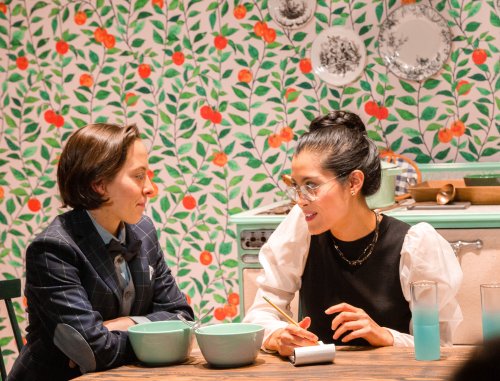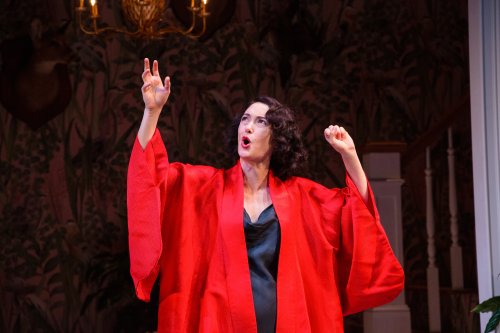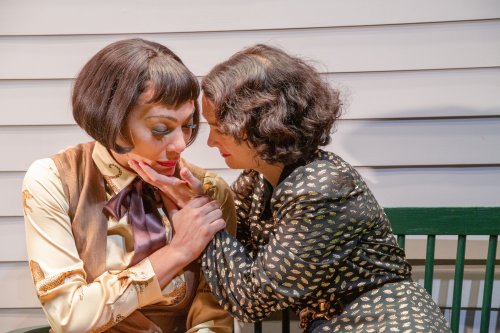Fefu and Her Friends
María Irene Fornés’ legendary 1977 play with its all-female cast and five sets side-by-side gets a rare revival.

Ronete Levenson, Lindsay Rico, Helen Cespedes, Jennifer Lim and Brittany Bradford in a scene from the revival of María Irene Fornés’ “Fefu and Her Friends” at Theatre for a New Audience (Photo credit: Henry Grossman)
[avatar user=”Victor Gluck” size=”96″ align=”left”] Victor Gluck, Editor-in-Chief[/avatar]
Ever wonder what women talk about when they get together? María Irene Fornes’ legendary 1977 play Fefu and Her Friends brings together eight women friends for a spring weekend at the New England country house of Fefu (whose real name turns out to be Stephany Beckmann). Spending the day together, the women talk of love, death, the men in their lives, their lovers, friends, each other, gossip, memories, their fears and their philosophies. Not much surprise here except that several are misogynistic: Fefu says her (offstage) husband married her in order “to have a constant reminder of how loathsome women are.” Another thinks that “the human being is of the masculine gender.”
More well-known by the reading public than the theatergoing members, Fefu and Her Friends is being given its first New York revival since its original production. Aside from the fact the play may have dated badly, it has a unique requirement which may keep theaters from doing it. After the first scene which takes place in a handsomely appointed living room, the author requires that for the second part, the simultaneous action of two-character scenes take place in four separate sets to which the audience travel around to see each one in turn.

Ronete Levenson and Lindsay Rico in a scene from the revival of María Irene Fornés’ “Fefu and Her Friends” at Theatre for a New Audience (Photo credit: Henry Grossman)
Not only do the actors have to perform each ten minute scene four times, but the audience has to be broken into four groups and moved from location to location: the lawn, the study, the bedroom and the kitchen. Although Adam Rigg’s sets are beautiful and one marvels at his ingenuity in getting them all onto the stage of Theatre for a New Audience’s Polonsky Shakespeare Center, in Lileana Blain-Cruz’s elegant production there doesn’t seem to be any point to all of the moving around other than that the characters have private places for their tête-à-têtes. And it will be difficult for theatergoers in wheelchairs or who have trouble walking or sitting on cushions or high tops to make the journey.
Unaccountably set in 1935, the play’s dialogue is as brittle and artificial as that of a Philip Barry or S.N. Behrman play from that time period. Dressed in Montana Levi Blanco’s chic designer style costumes, the women appear to be very wealthy, except for the beautifully appointed and coifed Paula (Lindsay Rico) who states that she felt out of place at college among them. The ostensible reason for the gathering is to prepare for a benefit fund raiser for advances in primary school education in which most of the women are to give speeches; however, this is not discussed or rehearsed until the play’s third and last part.

Helen Cespedes in a scene from the revival of María Irene Fornés’ “Fefu and Her Friends” at Theatre for a New Audience (Photo credit: Henry Grossman)
In the course of the afternoon and evening, we discover that Julia (Brittany Bradford) – who is in a wheelchair since a strange event in which a deer was shot but she received a psychosomatic injury – is prone to hallucinations; Paula and Cecilia (Carmen Zilles) were previously lovers but are no longer together; Cindy (Jennifer Lim) has broken up with Michael (whether her husband, partner or boy-friend we never know); Christina (Juliana Canfield) is prone to a great many fears; and that Fefu (Amelia Workman) who claims to be in some sort of dangerous game with her husband is certain that she has already lost him.
Although all of the acting seems rather affected in the manner of drawing room comedy (rather unusual for Fornés), Blain-Cruz obtains very varied performances from her octet of actresses. Workman’s Fefu is both commanding and self-possessed, though ultimately reveals herself to be quite emotional. Lim’s Cindy is both understanding and compassionate towards the others. Rico’s Paula seems very keyed up like someone in the throes of a recent, bad break-up. Cespedes’ Emma who has a magnificent monologue during the rehearsals for the benefit proves to be very theatrical. Zilles’ Cecilia is very grand dame in both her behavior and her couture. Dressed in a suit and tie, Ronete Levenson’s Sue is quietly helpful without revealing much about herself.

Amelia Workman and Helen Cespedes in a scene from the revival of María Irene Fornés’ “Fefu and Her Friends” at Theatre for a New Audience (Photo credit: Henry Grossman)
While María Irene Fornés’ Fefu and Her Friends is considered a feminist statement, in performance the play seems not to be very revealing about women or their positions other than the fact that the cast is entirely female. Set among the very rich in the 1930’s, the play is liberated only to the extent that the women have enough money to do what they wish. With its attractive sets and stylish clothes and the novelty of moving from one set to the other, the play seems to be rather a period piece than a statement of women’s lib. Unlike such all-female plays as Hazel Ellis’ Women without Men, Clare Boothe’s The Women and Jane Chambers’ Last Summer at Bluefish Cove, Fefu and Her Friends does not have a lot to say although it remains entertaining throughout. Of course, it is possible that a women critic might have a very different take on this work.
Fefu and her Friends (extended through December 12, 2019)
Theatre for a New Audience
Samuel H. Scripps Mainstage of the Polonsky Shakespeare Center, 262 Ashland Street, in Brooklyn
For tickets, call 866-811-4111 or visit http://www.tfana.org
Running time: two hours and 15 minutes without an intermission






Leave a comment